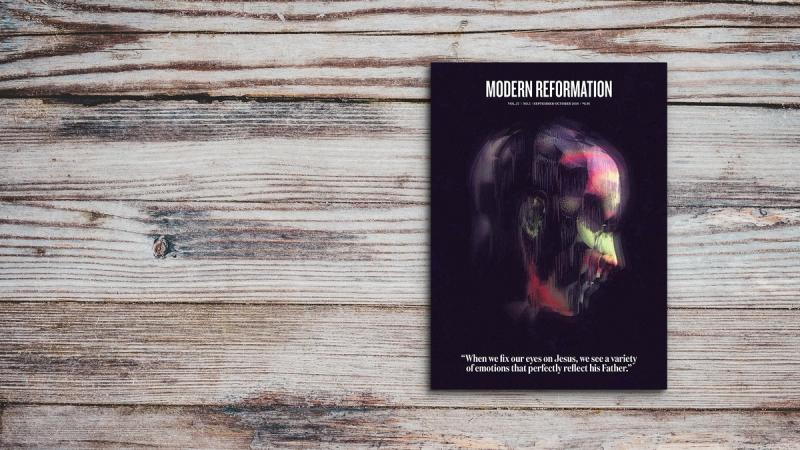For the past thirty years, I’ve worked as a professional realist, specializing in the hyper-realist style. My artistic education nurtured my affinity for the paintings produced during the Reformation, but my understanding of the theological developments from that period took somewhat longer to develop. Like most Bible-believing Christians in our day, I began my spiritual life under the guidance of the experts who ran the megachurches and published the best-selling Christian books. Without even realizing it, I adopted a foundational cluster of beliefs that caused me to accept aspects of my life and my church that were at best counterproductive and at worst sinful. I have spent a great deal of time thinking about the parallels between my growth as an artist and as a Christian, how the various instructors and pastors helped me to clarify my own vision and informed my understanding about who God is and who I am, and the various challenges that God was pleased to use to stimulate my studies. The journey from popular evangelicalism to the Reformation tradition was for me (as it is for many) a long one, and the similarities between that and my growth as an artist have always struck me as an interesting example of God’s providence.
When I think back on my early days as a Christian (I was converted in high school), I’m very thankful for the many things I learned, the lifelong Christian friends I made, and the high regard for Scripture that was instilled in me from the beginning of my faith. I knew that I needed Jesus to forgive my sins, so I naturally began to try to “show” him that I was a good enough servant. I had “made Jesus my Savior,” and now I would work hard to “make him my Lord” in all areas of my life. Although I had always displayed artistic ability and competence, I had some difficulty understanding the role that art might play in my life as a Christian adult. The impression I gleaned from my church and fellow believers was that the evangelism and conversion of the lost was the highest and holiest vocation any believer could aspire to, so much so that anything else seemed superficial and almost unworthy. Nevertheless, I decided that I really wanted to be a painter more than anything else. Because I had been reading books by C. S. Lewis and Francis Schaeffer, I developed a fairly healthy understanding of the role the arts could play in the life of the Christian and in the church, although I never had any formal discipleship or theological training. I enrolled in a big state university and took as many art classes as I could, as well as some courses in philosophy, music, and history. In college, I was confronted with non-Christian viewpoints and had to really think through my beliefs in order to maintain my faith. At the same time, interestingly enough, my desire to be a realist artist was being challenged by my art professors. Even my instructors in my introductory courses (Drawing, Painting, and Sculpture) considered the traditional mediums largely unnecessary (perhaps even harmful) in the drive to move art progressively into the future.
I remember the day some fellow students in my Drawing 101 course gathered around my desk to watch me sketch something. Our professor remarked that my work wasn’t that good, and that artwork with obvious mistakes was more interesting. He advised me to “loosen up,” and I became so frustrated by the lack of clear training that I violently scribbled across my drawing and ruined it. The professor pronounced it “much better.” These and other similar experiences in my art classes showed me that the definition of “art” was completely different from what I’d understood it to be. It seemed that modern art wasn’t about accurately representing what we see and experience in the world, but more about making a sociopolitical or philosophical statement, and I wasn’t sure I wanted to go that route. I loved art that was beautiful and well-crafted, art that hints at the transcendent reality in the limited materials of its medium.
As I was struggling with the confusion and frustration created by my art classes, I was also taking courses in art and European history. I became more acquainted with the Renaissance and the Reformation, which gave me a solid reference point to work from. Reformation artists, such as Albrecht Dürer and Hans Holbein, became role models for me. My preferred style of realism was practiced by time-honored artists, and that encouraged me. I had read Francis Schaeffer’s How Shall We Then Live? I therefore had a passing familiarity with the Reformation, but discovering the work of these men who did wonderfully detailed and lifelike works was a revelation. They used their art to say something about the human condition and God, not through the symbolism and spiritualistic execution of previous generations, but through a realistic representation that pointed toward a heavenly reality. Since I had found a style of art that resonated with me, I rather offhandedly decided that I would ignore the modernist ideas about art being propagated by much of the university staff, and I would attempt to paint in a realist style.
It appears to me that modern art theory was so busy trying to be progressive, open-minded, and intellectual that it unhelpfully jettisoned the historical and structural underpinnings of the discipline that gave it its power. When I asked questions about what certain abstract and crudely crafted pieces were trying to communicate, I often received abstract and superficial answers: “This unattractive metal sculpture is exploring the sense of place that ugliness has in public spaces.” “These poorly crafted and unimaginative giant boxes are a statement about how capitalism puts people in boxes.” Although I understood and could speak the language of this kind of art, I didn’t find it compelling enough to pursue. I noticed how university art students often spent little time on craftsmanship because they were encouraged to be radical and avant-garde, which meant that eventually no one was radical or avant-garde. As I look back on this period in my education, I see that I really just wanted to be left alone to make good realist art, and the philosophical issues I saw informing modern art at the time were simply not interesting to me. I had found my style and I wanted to hone it.
After a year and a half, I entered a more traditional art school and received training that greatly accelerated my technical skills as an artist. Although I learned a lot in a short amount of time, I wanted to pursue an extremely detailed style of painting, which was generally frowned upon by most of the staff. Eighteen months later, I ran out of money, and my new wife and I decided it was the perfect time for me to take a chance on an art career, since we had no children or large expenses yet. Shortly thereafter, an exclusive gallery began selling my paintings.
My art career (like my theological growth) was a hundred times more difficult than I imagined, but by the grace of God we survived. Looking back, I can see a connection between my need to show God that I was a good enough servant and my need to make ridiculously realistic paintings—almost as if I could validate my faith to the world through my art. (It’s also true that, like most people who have something they’ve worked hard to display, I’m a show-off and I like the attention my paintings bring me.)
I raised my family as a faithful evangelical until I found myself (along with many others) the father of adult children who had largely abandoned Christianity. I watched an entire generation raised on Veggie Tales and Adventures in Odyssey reject the faith of their parents as if it were a bad nineties sitcom. I think at least part of what has caused them to reject Christianity is the pandering that characterizes some evangelistic methods. When church is marketed like a weight-loss program or new coffee shop instead of the fellowship of Christ’s body, it’s not surprising that those raised in that environment get bored and begin to want something new. It’s no longer a church; it’s a fad. When the church emphasizes the gift of salvation in the person and work of Jesus Christ, and not just moral improvement and earthly success, it frees itself from the burden of fulfilling expectations it was never able to fulfill and becomes what it was always intended to be.
In my late forties, I came to realize that I had been skimming across the surface of Christianity. As I surveyed the damage dealt by shallow theology, cultural assimilation, and broken promises, I decided to dig into the study of theology and the history of the church. One of the best things I did was to deliberately ignore the popular “super pastors” and seek out better sources of information—not because they were all wrong, but because I just wasn’t sure who to trust anymore. It was a difficult time: I was excited to learn what exactly the church was and more about the relationship between my faith and Christ’s work, but I was also angry at the continual upheaval I experienced, as each erroneous foundational idea (usually gleaned from one of the super pastors) was confronted.
Just as I had felt no compulsion as a young man to adopt many of the assumptions about modern art, I eventually discovered that many modern evangelical ideas weren’t nearly as new and innovative as they appeared. My studies of church history showed me that many of the bad ideas currently undermining the gospel message in today’s modern church are often just rehashed examples of revivalism, pietism, mysticism, and individualism all mixed together with a dab of pragmatism and a side of postmodernism.
While the desire to reach unbelievers is a noble and worthy goal, I noticed that our eagerness to accommodate the surrounding culture was resulting in a church that assimilated into the culture instead. I became convinced that “doing life together” and “being the only Bible your friends will ever read” could only be done rightly if the gospel of God’s salvation in Christ applied by the Holy Spirit was clearly preached through word and sacrament. We can and should meet unbelievers wherever they are, but we can and should be faithful to meet those unbelievers with good news, not just good advice.
My wife and I are happy to be attending a Confessional Lutheran Church where we participate in historical, liturgical worship that is saturated in Holy Scripture, along with brothers and sisters of every age and phase of life. I love the reverent music and profound hymns; the centrality of God’s word where Jesus Christ, the Risen Savior, is clearly taught and proclaimed every single Sunday as the Good Shepherd who gave his life for his sheep. I now come to Christ to receive something from him (namely, the assurance of my unmerited forgiveness), as opposed to offering him a worthy sacrifice of praise (or a painting). Whether my paintings will have some deep spiritual impact or just be seen as beautiful works of art is not as closely tied to my faith as it once was. Christ’s atoning sacrifice has made a way for me to be at peace with God, and my need to prove something through my art has faded. But it’s also true that I still like to show off a bit by making the best paintings I can, because showcasing the beauty of creation is, in a certain sense, a form of worship.
Steven Kozar is an artist, musician and blogger/podcaster at Messed Up Church.





